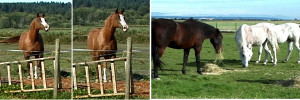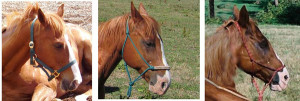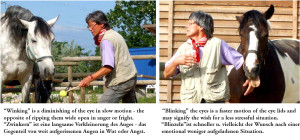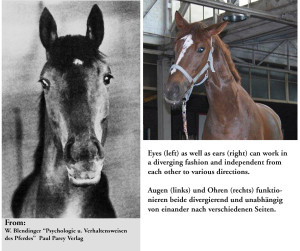Understand your Horse – Part 13
|
|
Ihr Pferd verstehen – Teil 13
|
Eyes 3
- In the last part we looked at different expressions of the horse’s eyes and noted, just as we did when looking at the ears, that they can be deceptive and one has to take care not to misunderstand – and miss a cry for help!
- We finished by looking at wide open eyes, which can express either worry, fright, real anger or panic. There is however one more situation, in which the eyes are opened quite wide – the frontal stare.
10. Frontal stare:
- In earlier Blogs, when discussing the human body language and how we can imitate the horse’s in order to communicate clearly with him, we already learned that a frontal stare signifies a demand for more space. WE did that by sticking out our chest, lifting the chin and staring the horse squarely in the eyes to make him yield backward.
- The horse does it by opening the eyes wide, staring directly and frontally at the opponent and by generally assuming the body stance as when trying to impress somebody.
|
|
Augen 3
- Im letzten Blog haben wir beim Betrachten des Ausdrucks der Pferdeaugen wie bei den Ohren schon festgestellt, daß es zu Trugschlüssen führen kann und wir uns bemühen müssen, ihn nicht mißzuverstehen – und somit villeicht einen Hilfeschrei zu verpassen!
- Zuletzt sahen wir weit aufgerissene Augen, die von Besorgnis, über Angst, Wut bis Panik ausdrücken können. Es gibt aber noch eine Situation, in der die Augen auch weit geöffnet werden – beim frontalen Anstarren.
10. Frontales Anstarren:
- Als wir früher schon die menschliche Körpersprache diskutiert haben und wie wir die der Pferde imitieren können, um uns besser zu verständigen, da haben wir gelernt, daß ein frontales Anstarren distanzfordernd ist. WIR machen das, indem wir die Brust vorwölben, das Kinn anheben und dem Pferd gerade in die Augen starren, um es rückwärts weichen zu lassen.
- Das Pferd reißt seine Augen weit auf und starrt ebenfalls seinem Gegner frontal und direkt in die Augen, wobei es oft die typische Imponier- Körperhaltung einnimmt.
|
 Left: Frontal stare with challenging body posture – right: … changes to a “bite threat” if not heeded.
Links: Frontales Anstarren mit Imponierhaltung – rechts: … wird zu einer “Beißdrohung”, wenn nicht beachtet.
|
- Head and neck are held high, the tail is also carried high, and the ears are pointed. (If the partner does not react, the position changes like shown on the right: ears get flattened and the head stretched forward as a bite threat.) Left this means “Let’s see what kind of stuff YOU are made of!” When your horse looks at you like that – realize that you are being challenged! If you plan to communicate your wish to remain boss, you must react! Let him yield, or send him away from you. Increase you own private space – demand more distance in turn.
11. Worry lines around the eyes:
- The left picture I found in the articles of “Barefoot – for riders who care”, where the author claims that horses can even develop worry lines around their eyes just like humans.
|
|
- Kopf, Hals und Schweif werden dabei hoch getragen und die Ohren nach vorn gespitzt. (Wenn der Partner nicht reagiert ändert sich die Haltung wie rechts gezeigt: Ohren angelegt und Kopf nach vorn gestreckt als Beißdrohung.) Links heißt es: „ laß sehn aus was du gemacht bist!“ Wenn Ihr Pferd Sie so anschaut, müssen Sie wissen, daß Sie herausgefordert werden! Wenn Sie Ihr Pferd wissen lassen wollen, daß Sie Boss bleiben, müssen Sie reagieren! Lassen Sie ihn weichen oder schicken Sie ihn von sich weg. Vergrößern Sie Ihren Privatraum, indem Sie ebenfalls mehr Distanz verlangen.
11. Sorgenfalten um die Augen:
- Das linke Bild habe ich im “Barefoot – for riders who care” gefunden, wo die Autorin behauptet, daß Pferde um ihre Augen herum Sorgenfalten entwickeln können wie Menschen auch.
|
 Real worry lines or just a matter of smaller or larger eye balls in relationship to the size of the head?
Richtige Sorgenfalten oder nur eine Frage der Augapfelgröße im Verhältnis zur Kopfgröße? |
- I can’t confirm that this horse actually worried so much… but it is yet another interesting thing to watch out for! Wilhelm Blendinger (in: Psychologie u. Verhaltensweise des Pferdes) seems to attribute the shape of the eye rather to the “noblesse” of the horse – breeds such as Lippizzans are said to have larger eyeballs in relation to the size of their heads than horses of less noble pedigree, which would therefore fill the bone cavity more completely (preventing folds – pictures right). A less noble horse with a smaller eyeball would tend to pull up the upper eye lid to clear the eyeball when opening the eye wide – thus creating skin folds above it, which could look like “worry lines”(left). Make your horse happy, so he has no reason to worry – and you have solved the problem, though we have no true scientific confirmation on this!
12. Dark rings:
- What I CAN confirm from my own horse Beau is that, when not well, overheated or too tired, he develops dark rings around his eyes.
|
|
|
 Left: eyes as normal – Centre: dark rings start to appear – right: Beau is in distress
Links: normale Augen – Mitte: dunkle Ringe erscheinen – rechts: Beau ist krank
|
- Left: Beau’s eyes normally look like this – centre: Dark rings appear, we must take it easy! Right: Beau is clearly in distress and needs help!
- It took me a while to realise his distress – I had not learned to pay enough attention to details. I clearly recognized the meaning of the dark rings one summer day, when all of a sudden Beau laid down in the field looking “collapsed”. He could have moved to the shade, but instead laid down with his head facing toward the stable, where he wanted to go to rest. I got him there with difficulty – all his friends gathering around him and following, which scared me even more – are they all preparing for his death?? It was not hot enough for a heat stroke – perhaps his heart? The vet checked him out, but we didn’t get any wiser. Since then I always keep an eye out for it and go really easy on him, when the dark rings appear – and so far so good. It pays to learn watching for details!
13. Your horse may wink at you!
- The kind of winking I mean is a “diminishing” of the eyeball size – so in other words the opposite of eyes ripped open (in anger or fright). So it expresses: “I am not in a flight mood – I have trust in you, I am not very vigilant at the moment”.
- Winking includes a motion of the eye, of course, but it is rather a slow partial closing and reopening of the eye. In a situation, where the horse might be forced (by his human or another circumstance) to go against horse etiquette, you may also observe the wink: for example, if you park your horse too closely next to a very high ranking one (who stares at yours demanding more distance), then it would tell the other horse “I am NOT staring at you, so don’t take it personally – I can’t help it, my human is forcing me to be here!”
|
|
- Links: so sehen Beaus Augen normalerweise aus – Mitte: die dunklen Ringe erscheinen und wir müssen ihn schonen! Rechts: hier ist Beau krank und braucht Hilfe.
- Ich habe eine Weile gebraucht, bis ich seine Notlage erkannt habe – ich habe damals noch nicht genug auf die Details geachtet. An einem Sommertag wurde es dann klar, als Beau sich mit solchen Augen im Feld hinlegte und „zusammengebrochen“ aussah. Er hätte in den Schatten gehen können, zeigte aber mit seiner Lage an, daß er in den Stall wollte. Ihn da hinzuschaffen war schwierig – und alle seine Freunde kamen mit, was mich noch mehr beängstigte – wollen sie ihm alle beim Sterben helfen?? Es war für einem Hitzschlag nicht heiß genug – vielleicht sein Herz? Die tierärztliche Untersuchung hat uns auch nicht schlauer gemacht. Seitdem aber passe ich immer auf, wenn die dunklen Ringe erscheinen, und schone ihn besonders. Bisher ging das gut – es lohnt sich, auf Details zu sehen!
13. Ihr Pferd zwinkert Sie an!
- Mit Zwinkern meine ich ein „Verkleinern“ des Augapfels – in anderen Worten das Gegenteil von Augen-Aufreißen (wie bei Wut oder Angst). Somit sagt das: „Ich bin nicht in Fluchtstimmung – ich hab schon etwas Vertrauen und zeig dir, daß ich gar nicht mehr so wachsam bin“ .
- Zwinkern beinhaltet natürlich Bewegung des Auges, aber ich meine damit ein relativ langsames teilweises Schließen und Wiederöffnen. In einer Situation, in der ein Pferd (vielleicht durch seinen Menschen oder andere Umstände gezwungen) gegen die Pferde-Etiquette angehen muß, z. B. wenn Sie es zu nah bei einem höherrangigen Pferd parken (welches Ihres anstarrt und Distanz verlangt), dann würde das Zwinkern dem anderen sagen: „ich starre dich ja gar nicht an –nimm es nicht persönlich, ich kann grad nicht anders, mein Mensch zwingt mich ja hier zu stehen!“
|
|

|
14. Blinking the eyes:
- By this I mean a faster motion of the eye lids. Once you start to look for it, you might be surprised how much blinking is going on in your horse’s life! This is of course not always done with the intent of communication – the horse moistens and cleans his eyeballs by moving the lids across just like we do – that is the function! But when it happens frequently while you are working with your horse, it often means that you are coming on a bit strong and the horse would wish for a slightly less emotionally charged situation. If this be the case, then you can so easily help your horse and thereby improve the partnership. Back off some – insert something more fun for a break or just pause and relax. We often get carried away – especially when things are going great! Then there is danger of becoming too demanding – and your horse might blink up a storm…
Summary eyes:
- We have seen that the eyes (as well as the ears) of the horse can work in a diverging fashion and independently from each other in various directions.
|
|
14. Blinzeln:
- Damit meine ich eine schnellere Bewegung der Augenlider. Sobald Sie anfangen mal darauf zu achten, werden Sie feststellen wieviel Blinzeln bei Ihrem Pferd abläuft! Das passiert natürlich nicht immer mit der Absicht der Kommunikation – auch das Pferd befeuchtet ja seinen Augapfel mit einem Blinzeln wie wir – das ist die Funktion! Wenn es aber oft geschieht während Sie mit Ihrem Pferd arbeiten, dann kann es bedeuten, daß Sie sich ein bißchen zu stark durchzusetzen versuchen und das Pferd sich eine weniger emotionsgeladene Situation wünscht. Wenn das der Fall ist, können Sie ihm so leicht helfen und damit die Partnerschaft verbessern. Ziehen Sie sich ein wenig zurück – legen Sie eine Pause ein und machen etwas für den Spaß. Wir lassen uns oft hinreißen, vor allem, wenn die Sache gut klappt! Dann besteht die Gefahr, daß man zuviel verlangt – und das Geblinzel geht los!
Zusammenfassung Augen:
- Wir haben gesehen, daß die Augen (genau wie die Ohren) des Pferdes in divergierender Form und unabhängig voneinander in verschiedenen Richtungen funktionieren.
|
|

|
- The eyes do not combine the pictures in the brain, except when looking straight ahead – the only time the horse sees a focussed and three dimensional picture.
- The horse has better night vision than we, but the adaptation from dark to light (and vice versa) is slower. We learned that they see colours very differently from us. So though the horse may see “worse” than us in terms of focus, there is no doubt that he sees much more than we! Where an eagle might have the “Tele lens” and the human the “normal lens”, the horse possesses the “wide angle” one and takes in an enormous amount of “panorama information” in minutest detail.
- Often the ears give us an indication of what the eyes are looking at – but the eyes also give us insights about the horse’s emotional wellbeing or state of health independently.
- We learned that the horse’s evolution put much more importance on detecting the minutest motion, rather than on a focussed image. This might explain, why a horse does not react strongly to moving cars – for the horse a car does not really “move” (it just gets bigger as it comes closer), because it does not flail legs or beat wings! ALL other moving beings in nature however do that!
We move on to other parts of the horse to understand his emotions!
Read on !!
|
|
- Die Augen kombinieren die beiden Bilder nicht im Gehirn, außer, wenn sie gerade nach vorne schauen – der einzige Punkt, wo das Pferd ein scharfes und drei dimensionales Bild sieht.
- Das Pferd besitzt eine bessere Nachtsicht als wir, aber die Adaptation von Hell nach Dunkel (und umgekehrt) ist bei ihm langsamer. Wir haben gelernt, daß es Farben ganz anders sieht als wir. Obwohl das Pferd in der Schärfe schlechter sieht als wir, sieht es aber zweifellos viel mehr! Wo der Adler das „Teleobjektiv“ und der Mensch das „Normalobjektiv“ besitzt, hat das Pferd den „Weitwinkel“ und sieht eine Menge Information gleichzeitig und in großem Detail im Rundumblick.
- Oft zeigen die Ohren an, was die Augen gerade betrachten – aber die Augen geben auch unabhängige Einsichten in das Gefühlsleben und die Gesundheit des Pferdes.
- Wir haben gelernt, daß die Evolution wesentlich mehr Gewicht auf das Erkennen der winzigsten Bewegung gelegt hat, als auf ein scharfes Bild. Das mag erklären, warum ein Pferd herankommende Autos so wenig beachtet – für ein Pferd „bewegt“ sich das Auto eigentlich nicht, (es wird bloß beim Näherkommen etwas größer) denn es wirft ja keine Beine oder schwingt Flügel! Jedes andere sich bewegende Wesen in der Natur tut das aber!
Wir sehen uns demnächst weitere Körperteile des Pferdes an, um seine Gefühle zu verstehen!
Lesen Sie weiter!!
|






